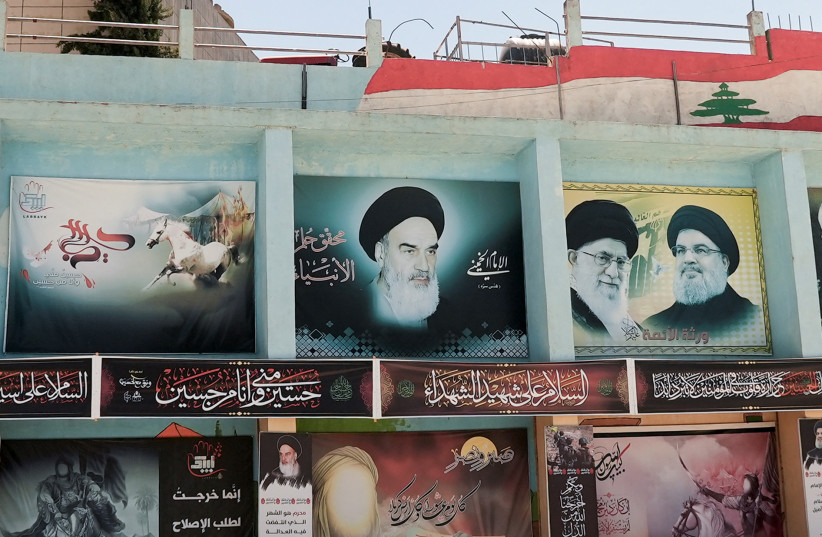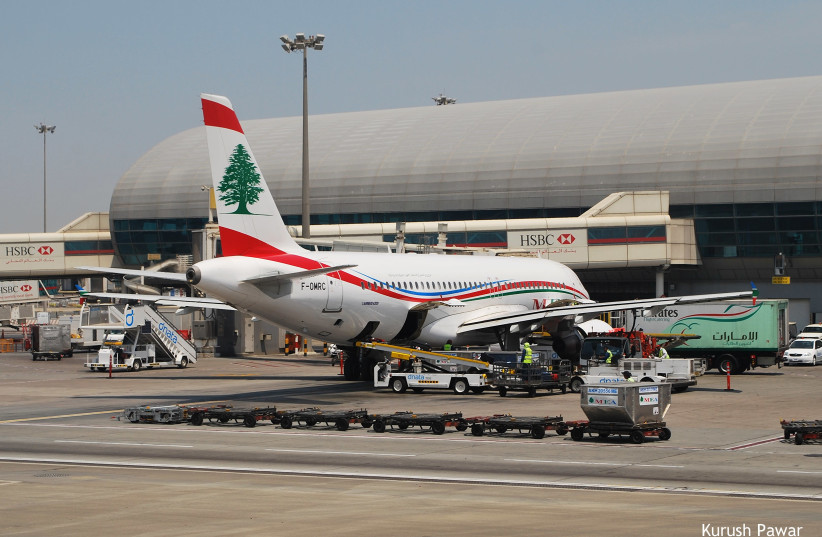by Seth J. Frantzman
Iran has trafficked weapons to Hezbollah for decades, improving its missile and drone programs. This has been a source of tension between Israel and the terrorist group.
 |
CURTAILING IRAN’S smuggling of advanced weaponry to Hezbollah:
Banners depict (from L) Iran’s late leader Ayatollah Ruhollah Khomeini,
Iran’s Supreme Leader Ayatollah Ali Khamenei and Hezbollah leader Sayyed
Hassan Nasrallah, in Yaroun, southern Lebanon, August 15.
(photo credit: REUTERS/ISSAM ABDALLAH)
|
Iranian arms smuggling to Hezbollah may be shifting course and could potentially create a crisis in Lebanon. Recent reports have indicated there is a focus on Iranian arms shipments to Beirut, or potential ones.
Iran has trafficked weapons to Hezbollah for decades, improving its missile and drone programs. This has been a source of tension between Israel and the terrorist group.
Jerusalem has acted to prevent Iranian entrenchment in Syria over the last decade during the Syrian civil war. This is called the “war between the wars campaign.” However, Lebanon is generally seen as separate from Iran’s use of Syria as a conduit, meaning that once weapons enter Lebanon, they have sort of reached a get-out-of-jail-free space.
On Saturday December 10, Asharq al-Awsat, a London-based Arab newspaper, said in a report widely quoted in the region that “Israel raised threats on Saturday of plans to bomb the Beirut airport if the terminal gets used as an Iranian weapons smuggling route, in a situation similar to what it did in Syria.”
“Israel raised threats on Saturday of plans to bomb the Beirut airport if the terminal gets used as an Iranian weapons smuggling route, in a situation similar to what it did in Syria.”
Asharq al-Awsat
The report said that “Israeli political sources in Tel Aviv said that Israel was aware of a report broadcast by the ‘Al-Arabiya Channel’ about Iran's plans to use a new smuggling corridor for its weapons through Beirut after the failure of the Damascus corridor. The sources said that Israel is investigating Tehran’s attempt to smuggle weapons through civilian flights to Beirut Airport.”

Lebanese Hezbollah terror leader Hassan Nasrallah is focused on shifting the Iranian arms shipments that usually go across Syria, according to the report. Iran uses Iraq and Syria as a corridor for weapons trafficking and basing of weapons. It has provided drones to militias in these countries and based drones at places like the T-4 base in Syria. It even flew a drone from T-4 into Israeli airspace in 2018, which Israel shot down.
In 2021, Iran launched a drone from Iraq at Israel during the May hostilities between Israel and Hamas. The Islamic Republic has now begun launching drones directly from Iran to threaten the Jewish state. Tehran also used a drone from Chabahar to strike a commercial ship in mid-November, which it apparently believed was Israeli-owned.
THE OVERALL pattern is clear. Iran backs Hezbollah, Hezbollah intervened in the Syrian civil war in 2012 to support the Syrian regime, and Iran backs the Syrian regime. It also backs militias and key political leaders and parties in Iraq.
Tehran moves ballistic missiles and drones to Iraq and also to Syria and Lebanon. It has also helped Hezbollah with its precision-guided munitions industry. This is a major threat to Israel because such munitions can target strategic infrastructure in mass attacks.
In July, Hezbollah sent drones to target a gas rig off the coast of Israel. This was a major warning that Hezbollah wanted to strike at economic interests off the coast.
In October, on the eve of Israel’s elections, Jerusalem and Beirut agreed to a maritime demarcation deal that gave in to most of Lebanon’s demands. Hezbollah and Iran have characterized the deal as a win for the terrorist group, Hezbollah now believes it can dictate to Israel.
The deal may also bring in Qatari investment, enabling Qatar to play a role in southern Lebanon, where Hezbollah is based, and also in Gaza where Doha has sent funds over the last few years.
The Alma Research and Education Center
Now the issue of Iranian weapons trafficking to Lebanon is back in the spotlight. The Alma Research and Education Center, founded by Lt. Col. (Res.) Sarit Zehavi and devoted to examining Israel's security challenges on the northern border, recently put out several tweets about Iranian issues.
One issue Alma has examined is the pilots of Iran’s Mahan Air “who have the potential to be involved in unit 190's weapon components smuggling to Syria/Lebanon in the past year. We have photos and additional information about them which we will begin to publish soon with the full report.” Unit 190 is a part of Iran’s Islamic Revolutionary Guard Corps Quds Force.
We suggest that @MahanAirlines pilots follow us carefully in the coming days, especially those who work with Unit 190 of the #Quds Force in "transports" to #Syria/#Lebanon. We are going to make you famous! pic.twitter.com/t37wURMHus
— Israel-Alma (@Israel_Alma_org) December 11, 2022
THE ALMA center has also asked “how many Shahed 136/Mahajar 6 UAV parts
can fit in your 41 planes' luggage compartment and be smuggled to
Damascus/Beirut airport for Hezbollah (assuming a fully booked flight
with passengers with carry-ons only?)” This claim appears to indicate
that Iran may be using Mahan Air to move munitions. The Shahed 136 drone
is the same type that Iran has supplied to Russia.
A professional question for @MahanAirlines CEO Mr. Arabnejad Hanoukhi:
— Israel-Alma (@Israel_Alma_org) December 12, 2022
How many Shahed 136/Mahajar 6 UAV parts can fit in your 41 planes' luggage compartment and smuggled to Damascus/Beirut airport for Hezbollah? (Assuming a fully booked flight with passengers with carryons only) pic.twitter.com/OhWRuONOFj
Another series of tweets by Alma focuses on Beirut International Airport and how “direct flights from Iran to [the Lebanese capital] have been taking place for years and two Iranian airlines maintain a regular flight route to this day.”
(1/4) The last time the international airport of #Beirut (Rafic Al-Hariri) was attacked by Israel was in July 2006. Direct flights from Iran to Beirut have been taking place for years and two #Iranian airlines maintain a regular flight route to this day. pic.twitter.com/BNUmN0Isrh
— Israel-Alma (@Israel_Alma_org) December 11, 2022
In 2019, the IDF exposed the identities of three senior officers in the IRGC and accused them of being “involved in Hezbollah’s attempt to develop and acquire precision-guided missiles in Lebanon.” In August of that year, Hezbollah also accused Israel of an attempted drone attack in Beirut. In September 2020, the military also revealed details of Hezbollah missile sites in the Lebanese capital.
The Jerusalem Post reported last week that “the IRGC-affiliated Meraj Airlines has begun flights to Beirut in recent days, raising concerns that Iran could use the flights to transfer weapons directly to Hezbollah in Lebanon instead of using Damascus.”
Hezbollah appears to be setting its sights not only on direct receipt of Iranian weapons via Beirut, but also wants to improve its air defenses.
Assaf Orion wrote at the Washington Institute for Near East Policy in July that, “in response to such efforts, Israel has reportedly struck air defense systems destined for transfer to Hezbollah throughout Syria’s civil war next door, including Russian-made SA-8 and SA-17 batteries as well as Iranian systems deployed to Syria. After a drone strike hit Hezbollah targets in Beirut in August 2019, Nasrallah vowed to shoot Israeli UAVs out of Lebanon’s skies.”
Nasrallah has boasted that Hezbollah’s air defenses have reduced Israel’s air activity over Lebanon.
Israel-Lebanon maritime deal
WITH THE maritime deal signed, the tensions with Hezbollah in Lebanon come at a complex time. Not only was the deal supposed to bring more peace and stability, with the chance for Lebanon to explore for natural gas and help solve its economic troubles, but the deal came on the eve of Israel’s elections.
Is Hezbollah hoping to exploit the fact that Israel is waiting for a new government to be formed, to push tensions? Or is Hezbollah truly suffering due to the campaign between the wars?
Iran has to juggle a lot of issues at the moment. It wants to threaten shipping in the Gulf of Oman using drones, it wants to smuggle rocket fuel to the Houthis in Yemen, it wants to continue to send drones to Russia, and it wants to support groups in Iraq and Syria. It also has used those groups to target US forces in Syria and also to target Israel.
This means Iran may be having trouble with priorities of which terror group to give funds and weapons to. The Post reported this week that “Iran has stopped channeling funds to a number of Palestinian factions, the Palestinian newspaper Al-Quds revealed on Sunday.” At the same time, it appears that there are a large number of illegal weapons being smuggled into the West Bank. Is Iran behind the smuggling?
What is Tehran’s goal with Hezbollah in Lebanon? Does it want to give it better air defenses? In April 2018, reports said that Iran tried to move its 3rd Khordad air defense system to the T-4 base. The system was hit by an airstrike when it arrived. Since then, reports have indicated Iran wanted to move more systems to Syria, similar to either the S-300 or less sophisticated systems.
Russia has been increasing its military alliance with Iran in recent months and this could involve technology and defense transfers, which could impact Iran’s calculations about Lebanon and Hezbollah and make it more reckless in supplying the terrorist group.
The maritime deal will also potentially create restraint by Israel in terms of confronting Hezbollah’s arms imports.
Seth J. Frantzman
Source: https://www.jpost.com/middle-east/article-724842
No comments:
Post a Comment